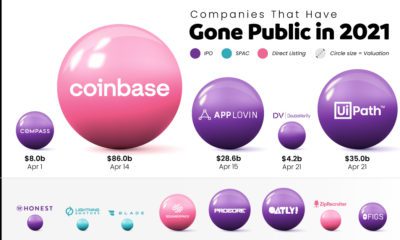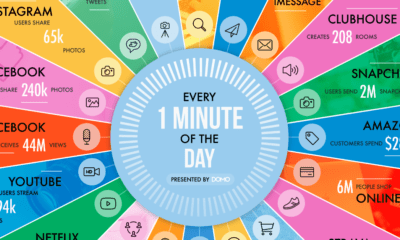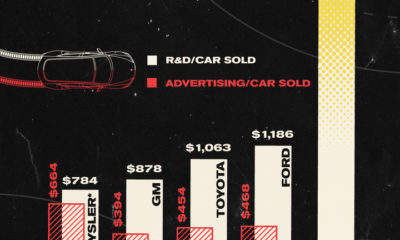Today’s infographic from Safe Company is a throwback to the 1980s and 1990s, making us nostalgic for the heyday of these popular gadgets.
Tech Goes Mobile
The gadgets of the 80s and 90s were all about taking existing technology and making it more enjoyable while on the go, rather than solely being useful in the home or office. Even if that meant devices that were “portable” in name only, it was a huge step forward. Devices like the Game Boy, Walkman, early Nokia phones, and other mobile technologies helped lead engineers to solve the problems that would lay the ground for today’s “world in the palm of your hand”. Improving power consumption efficiency, developing new battery types, reducing size, creating screens that were readable in a variety of light conditions, and even opening up the demand for aftermarket accessories were among these advancements.
Broadening Media Access
The latter 20th century will be remembered for democratizing access to all kinds of information, both for work and for play. Technologies of the 90s set a precedent for the bite-sized span of modern digital attention. Microsoft’s Encarta encyclopedia suite allowed comprehensive keyword search before the optimization of online alternatives. Simply type a word, and get every piece of information related to it – without the need to purchase updated versions including new data each year. It sounds almost comical to tout these as features in the age of Google, but compare Encarta to the alternative: carrying around a set of Encyclopedias! On the leisure side, the wildly faddish Tamagotchi feels like a forebear of 2010-era mobile games – cleverly designed to create a cycle of short, addictive bursts of play with a low cost of access. The ever beeping, cutesy reward loop of caring for your Tamagotchi may have annoyed a generation of parents, but it inspired a whole genre of bite-size digital entertainment. Even the Walkman launched a new frontier of access to media through the creative possibilities of mixtape-making, bootlegging, and sharing tapes. I’m sure anyone who grew up in the 80s and 90s had a shoebox full of favorite tracks taped from radio and vinyl… or was that just me?
Old Tech, Lasting Impact
Though it is easy to downplay the quaint technologies that came nearly thirty years ago, we can’t ignore that its influence is in the DNA of the devices and digital interactions we encounter every day. Go back through your closets, dig out your Game Boy, and take a trip back in time to remember the curiosities and comforts of old-school tech!
on But fast forward to the end of last week, and SVB was shuttered by regulators after a panic-induced bank run. So, how exactly did this happen? We dig in below.
Road to a Bank Run
SVB and its customers generally thrived during the low interest rate era, but as rates rose, SVB found itself more exposed to risk than a typical bank. Even so, at the end of 2022, the bank’s balance sheet showed no cause for alarm.
As well, the bank was viewed positively in a number of places. Most Wall Street analyst ratings were overwhelmingly positive on the bank’s stock, and Forbes had just added the bank to its Financial All-Stars list. Outward signs of trouble emerged on Wednesday, March 8th, when SVB surprised investors with news that the bank needed to raise more than $2 billion to shore up its balance sheet. The reaction from prominent venture capitalists was not positive, with Coatue Management, Union Square Ventures, and Peter Thiel’s Founders Fund moving to limit exposure to the 40-year-old bank. The influence of these firms is believed to have added fuel to the fire, and a bank run ensued. Also influencing decision making was the fact that SVB had the highest percentage of uninsured domestic deposits of all big banks. These totaled nearly $152 billion, or about 97% of all deposits. By the end of the day, customers had tried to withdraw $42 billion in deposits.
What Triggered the SVB Collapse?
While the collapse of SVB took place over the course of 44 hours, its roots trace back to the early pandemic years. In 2021, U.S. venture capital-backed companies raised a record $330 billion—double the amount seen in 2020. At the time, interest rates were at rock-bottom levels to help buoy the economy. Matt Levine sums up the situation well: “When interest rates are low everywhere, a dollar in 20 years is about as good as a dollar today, so a startup whose business model is “we will lose money for a decade building artificial intelligence, and then rake in lots of money in the far future” sounds pretty good. When interest rates are higher, a dollar today is better than a dollar tomorrow, so investors want cash flows. When interest rates were low for a long time, and suddenly become high, all the money that was rushing to your customers is suddenly cut off.” Source: Pitchbook Why is this important? During this time, SVB received billions of dollars from these venture-backed clients. In one year alone, their deposits increased 100%. They took these funds and invested them in longer-term bonds. As a result, this created a dangerous trap as the company expected rates would remain low. During this time, SVB invested in bonds at the top of the market. As interest rates rose higher and bond prices declined, SVB started taking major losses on their long-term bond holdings.
Losses Fueling a Liquidity Crunch
When SVB reported its fourth quarter results in early 2023, Moody’s Investor Service, a credit rating agency took notice. In early March, it said that SVB was at high risk for a downgrade due to its significant unrealized losses. In response, SVB looked to sell $2 billion of its investments at a loss to help boost liquidity for its struggling balance sheet. Soon, more hedge funds and venture investors realized SVB could be on thin ice. Depositors withdrew funds in droves, spurring a liquidity squeeze and prompting California regulators and the FDIC to step in and shut down the bank.
What Happens Now?
While much of SVB’s activity was focused on the tech sector, the bank’s shocking collapse has rattled a financial sector that is already on edge.
The four biggest U.S. banks lost a combined $52 billion the day before the SVB collapse. On Friday, other banking stocks saw double-digit drops, including Signature Bank (-23%), First Republic (-15%), and Silvergate Capital (-11%).
Source: Morningstar Direct. *Represents March 9 data, trading halted on March 10.
When the dust settles, it’s hard to predict the ripple effects that will emerge from this dramatic event. For investors, the Secretary of the Treasury Janet Yellen announced confidence in the banking system remaining resilient, noting that regulators have the proper tools in response to the issue.
But others have seen trouble brewing as far back as 2020 (or earlier) when commercial banking assets were skyrocketing and banks were buying bonds when rates were low.














